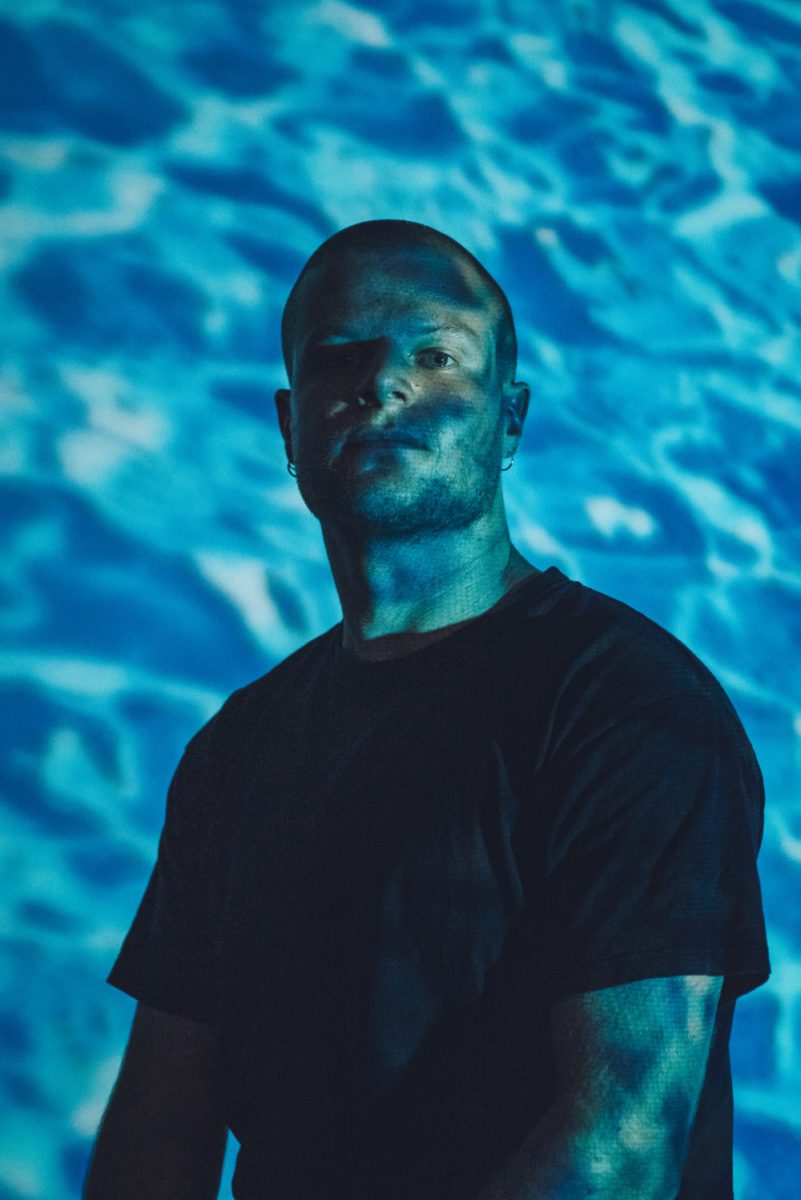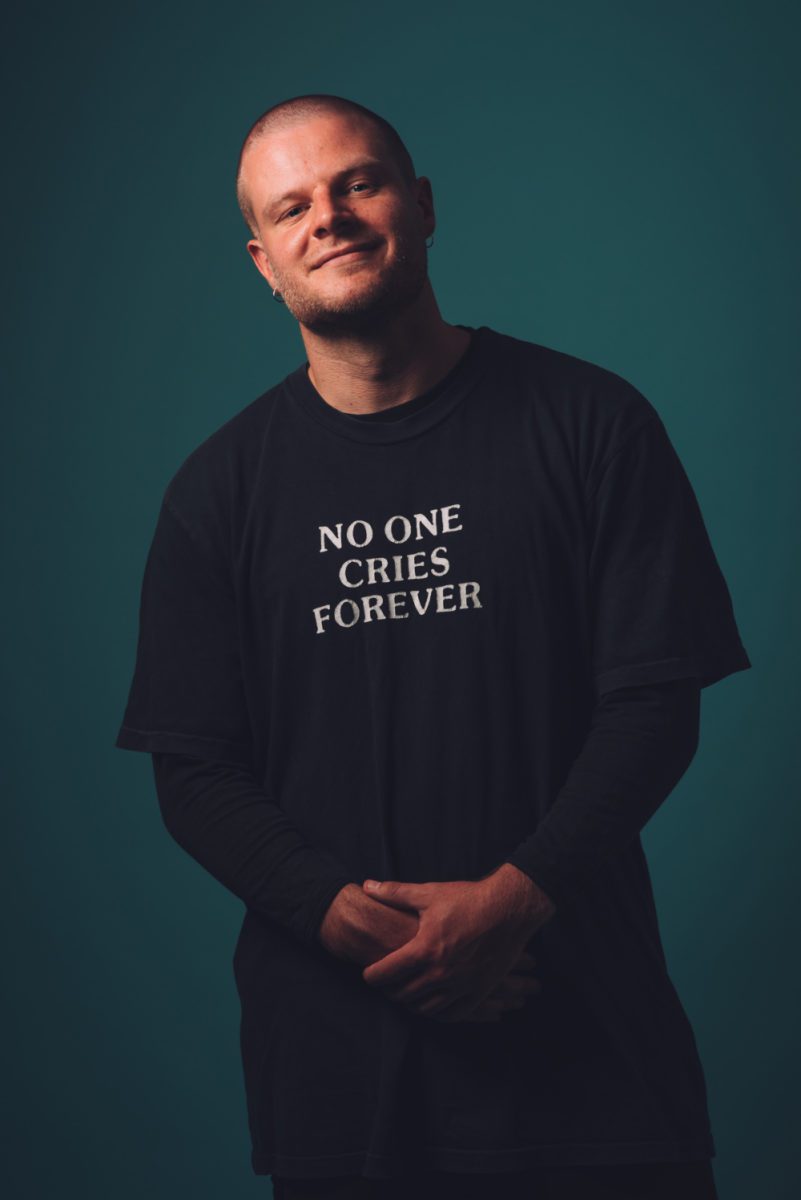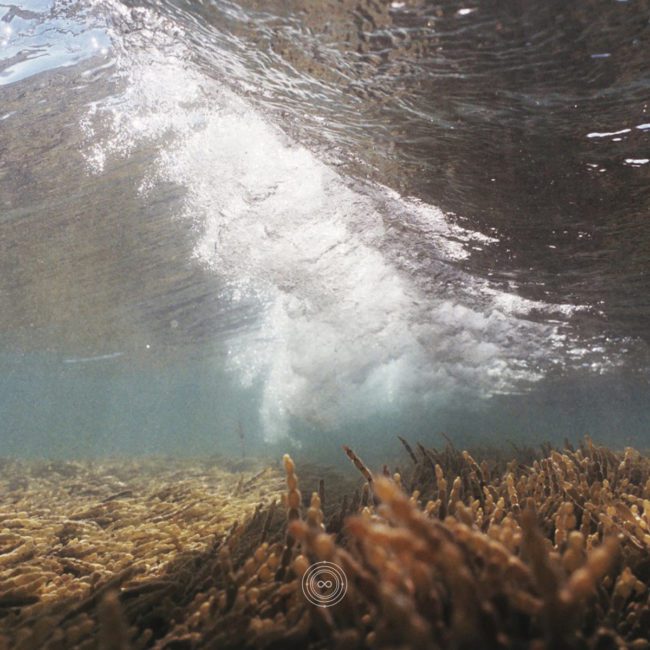Long-standing relationships between label and artist are common, but the instances that show the signs of mutual growth and development are a little rarer. The development of Infinite Machine and Galtier is one such relationship, traceable from Galtier’s first EP, for the label’s 46th release, to the present.
Three EP’s made way for the Bristol-based producer’s most recent album, ‘Pulchra Es Elementis‘, released earlier this month on digital and also as a rare LP from the predominantly net-based label. It’s a feat that could only have been achieved by trust and faith between label and artist: since first working together, Galtier’s style of production have shifted, and although the fingerprints remain the same, this new LP seems to be possible as a result of mutual understanding of the goal of the art.
Galtier’s name was somewhat honed within the explosion of popularity that the Hard Drum genre movement enjoyed from a few years back, a take on dance music that showed a predilection for tough, intertwining percussion. ‘Pulchra Es Elementis‘ demonstrates no small amount of maturity, and a balancing of sound, where emotional synths begin to take more of a foreground — sometimes dominating a track’s flavours entirely.
Certainly remaining within the sphere of dance music, Galtier solidifies his position as a commanding authority on percussive grooves, while simultaneously reaching into more esoteric ambient territory on tracks like ‘Wilfull Saviour‘: this itself bears hallmarks of his relationship with Infinite Machine, a label comfortable releasing works by ambient auteur’s like Keru Not Ever, as much as it is unleashing EP’s like Galtier’s previous outing, ‘Dancing On Ruins‘, a blistering assault on the clubland.
In this mix for Inverted Audio, Galtier shows off his tastes for wistful ambient music, touching on classics from Andy Stott, Vangelis, Aphex Twin, Barker and Ryuchi Sakamoto, while also wielding futuristic club gear from Elise Massoni, GILA and Machinedrum to create sharp-edged accents to smooth surfaces.
In our interview, we discuss his sources of inspiration and the development of his musical practice, plus his love for ambient music – from the emotional content it can procure to the differences in production tactics. We also discuss the future of his own Nostro Hood System imprint and what lies in store next for Galtier.
Interview by Freddie Hudson

"I didn’t really know how to convey it in words so I decided to try and use music to capture the vestiges of what I had felt"
We’re really absorbed in this album. A translation of the title into English is “Elements are Beautiful”: Can you give us some personal insight into the decision behind the naming here?
Thanks for having me! Glad you’re feeling the album and it is resonating with you. The name of the album stems from the culmination of my thoughts and feelings, throughout what was and still is, a spiritual introspective journey I decided to embark on a few years ago.
I found myself doing a lot of reading around philosophy and psychology during this time and started to meditate and practice mindfulness in various ways, honing-in on myself in an acute way. It wasn’t a particularly fun experience, but it was wholly meaningful and I do not regret any of it.
The whole experience was originally intended to be an exploration myself and what it meant to be me; why I was the way I was, and how I could help myself to become someone who could grow into an ever-greater version of me, who felt more connected to my inner being.
Inadvertently, it eventuated into a deeper sense of connectedness to something greater than I; I had felt myself truly being a part of a larger, fundamental plane of existence. My atoms were a component in the universe and therefore the universe was in me, and in everyone else and everything.
This was so profoundly beautiful that I didn’t really know how to convey it in words so I decided to try and use music to capture the vestiges of what I had felt in those moments of clarity. I originally wanted to call the album ‘Beautiful Carbon’ but thought the name sounded too similar to the sci-fi series ‘Altered Carbon’ so played around with similar words in Latin. I chose Latin as it is the language of many great philosophers whose work I admire so I decided to pay homage to them through this simple motif.
How did you approach making the record? Did anything fundamental to your production change, in comparison, say, to the ‘Dancing On Ruins’ EP, previously out under the same label, Infinite Machine?
When I started writing the album I wrote down a piece that I wanted to use to inform my feelings when engaging in the production of the record. I would read it and bring out the sensations that I had felt from time to time over the years that really made me feel alive and in tune with the vibrations of the universe.
I decided to record this exact piece and place it at the start and end of the mix so for an insight into what this was you will find it there. Along with this I also more or less had written the titles for each of the tracks before I had even produced them. I used the names as a guide as to how I wanted the tracks to sound and the flow of emotive growth and shifting I wanted to convey on the record.
This is a starkly different approach to anything else I have made, with a lot of my previous releases being more of an amalgamation of tracks that suited each other well that I pieced together from my selection of demos I had worked on. This was how I made the ‘Dancing On Ruins’ EP, but since that EP I have tried to focus in on a theme and have some upcoming projects that are much more bound together from the get go than previously.
Percussion has been one of the cornerstones of your tracks until now, and whilst this album certainly makes use of a drum kit, it could be argued that the emotive synths are elevated a little more here. Would you agree, and can you explain the decisions here if so?
I would agree with this observation – I think that to capture the feelings and place that I was taken to while making the album begged for there to be a much more predominant presence of melodic instruments across the whole release. I do think it is also possible to capture certain feelings through percussion though, as I made the much more darker tracks like ‘Phantasiai’ and ‘Cavernam’ are disjointed and broken.
It is these tracks and these tracks alone that have this quality to them; the more uplifting tracks flow much more fluidly and feel less broken and fragmented. I really tried to bring forth a combination of both on the release as I think it is important to keep the traits that I have become known for evident in the work but to also let branches of sonic growth extend out for something that is intended to be meaningful like this project.
Infinite Machine have rarely crossed over from digital releases to vinyl. Did you know this album would be released on vinyl as you produced it, or did this come after submission? Did the format affect your approach to the production in any way?
I know, right? It is truly an honour to be one of the few! There was talk for a long while about working on an album and deliberation over whether or not it would be pressed, but it was finally decided that it would be and I think this was after I had started to piece together some ideas. I can’t really recall exactly the finer details but knowing that it would be pressed onto vinyl was a hugely encouraging factor to make it all the more special.
It affected it with regards to how particular I would make the selection of tracks, and logistically it also meant I had to consider the running time to fit onto the record. I had a few more tracks I had started which didn’t make the cut unfortunately. I am really happy with the selection that we chose though and think these tracks capture the energy I was conveying really well.
What would you describe as being the central themes of the album, both sonically, and metaphorically?
Sonically, it is hugely influenced by the grandiose soundtrack of Bladerunner by the great Vangelis, and furthermore the Bladerunner sequel by Hans Zimmer & Benjamin Wallfisch – the visceral emotions drawn out from the way each soundtrack has been composed is just utterly breath-taking for me and so I tried to bring that same vitality to my own productions. Those films really touch on deep, existential themes too and this is something that the album intends to explore as well.
On a more metaphorical level it is influenced by the experiences I have had in my life and likewise from works I have read from schools of thought such as the Ancient Greek Stoics, the 1920’s Existentialism and Absurdism, and Buddhism just to name a few.
This is more evident through the track names and the state of mind that I was in when I sat down to actually make the music. It is the unification of the past and future for me; the soundscapes of a future world paired with the teachings and musings of the past.
You also run your own label, Nostro Hood System. Can you talk us through the vision of the label, and the types of sounds you release?
This is correct! The Nostro Hood System is a hypothetical galaxy that is not the one we occupy – it is a separate realm in the universe with its own stars, its own suns and planets that orbit around them. The music on the label is meant to be the sounds created by the communities that live on the planets that reside there.
We are only able to hear these sounds as they have been projected through space and picked up by the designated ‘Xenologist’ team on earth who take the audio files and process them so as to allow humans to hear them using our earthly aural senses.

"I like the idea of the music from another galaxy being bizarre and leftfield, thus many of the releases are enigmatic and oblique in nature"
This allows for the selection of releases to be quite eclectic and varied. I like allowing artists to experiment and try something different when producing a release for NHS. I don’t want it to just be pigeon-holed into a club label so more and more I open up the direction that the label will take sonically.
I like the idea of the music from another galaxy being bizarre and leftfield, thus many of the releases are enigmatic and oblique in nature. For me as long as an artist’s work is aiming to be unique and otherworldly then it has the fundamental hallmarks of a potential release on the label.
In your opinion, what do you think the most important features of a modern electronic music label are?
It all depends on what you are trying to achieve with the label in my opinion. For me I wanted to stand out and create a different world with the label which means it is quite thematic in nature, but many labels are much more simplistic than this which in no way devalues them.
Perhaps, for me, it is to find something that you want to focus on with the label so that it is concise and has purpose in some shape or form. Create the brand and make it stand out in a certain way so that it is recognisable just by a glance at an artwork or at the sound of a particular release.
Your early productions have been described as helping form the ‘Hard Drum’ genre, which swiftly gained cult-level popularity among some exponents: can you tell us your perspective of this? How much do you feel that label helps define your music?
I can see how this link can be made based on many of my works from around 2 years ago but I don’t know if this is really indicative of what I am doing now. There was a time when such a sound was really inspiring for me as the sense of rhythm was so good to dance to and my friends were all making stuff like this, so I followed it for a while.
These days I am much more free with what I create and try not to set too strict limitations on what I do. This feels like a maturation of my sound to me. Certainly elements of Hard Drum still remain in some shape or form, like the rhythm of ‘Phantasiai’ on my album, and the percussion palette of both real-life percussion and much more mechanical sounds coming together that I tend to lean towards.
As time goes on, though, the core of this association fades away naturally as I follow more and more what I want to do and not what I think people will like. I feel like this coincides with a much greater sense of self as a person, too.
Back to the album, there’s a definite duality between pounding club gear (‘U Were, U Are & What U Will Be‘) and plaintive ambient music (‘Pulchra Es Elementis‘). What are your key inspirations behind splitting the release as such? Do you feel that non-club music makes an album more concrete, artistically?
Two main reasons: I love making ambient music as an alternative approach to music production. It is so different to making rhythmic music and demands a different approach to how I produce. This is a welcomed challenge for me and the album felt like the perfect place to test it.
Secondly, for me I felt that the album needed to have moments of respite throughout to match the existential themes I tried to personify; life has its moments of respite and flow, much like water, so I made moments where it felt much more harmonious to capture this sense of homeostasis amongst the passionate chaos of life.
This doesn’t at all suggest that the same approach is imperative for other artists; I think it all depends on what you are trying to achieve and to say with the record. It is subjective and personal, so if someone wants to offer an album worth of danceable tracks or the opposite, then that is their prerogative – that’s what they want to give to the world.
Finally, we’d like to ask what else you have in store for the next year: Are you back to playing shows, perhaps touring with the album, or do you have any releases coming up on your label?
I am looking into touring Switzerland and Asia either this year or next year, a sort of late celebration of the project. This is dependent on obvious factors but hopefully will be able to sort out some dates! I have lots of new Galtier projects in the pipeline ready for 2022, taking form as singles, remixes and EP’s. Likewise there are a slew of new releases from some remarkably talented people on NHS that I really can’t wait to share either!
‘Pulchra Es Elementis’ is out now via Infinite Machine. Order a copy from Bandcamp.
Photos by Giulia Spadafora
TRACKLIST
1. Vangelis – Opening Theme
2. Galtier – Crystalised Larva
3. syntrovert – Confianza (No Drums)
4. Aphex Twin – I
5. Joe Hisaishi – Painters
6. Mokona – Natalie’s Aquarium Lab
7. Andy Stott – When It Hits
8. Mpu101 – Sys1finmwitch
9. Terekke – Soft G
10. Disasterpiece – Jay
11. Daniel Avery & Alessandro Cortini – Baresi
12. Andy Stott – Too Many Voices
13. Galtier – (U Are) Beautiful
14. Klara Lewis & Peder Mannerfelt – Sell Art
15. GILA – Stretch Chord
16. Galtier – Journeyman
17. Galtier – Pulchra Es Elementis
18. Ryuchi Sakamoto – Life, Life (Andy Stott Remodel)
19. Ryuchi Sakamoto – Life, Life
20. Machinedrum – Opalescent
21. Barker – Utility
22. Leon Vynehall – Mothra
23. Superficie – Mara
24. Elise Massoni – (9_9)4 Romantics
25. PLATA – HITEK
26. Vangelis – Tears In Rain

